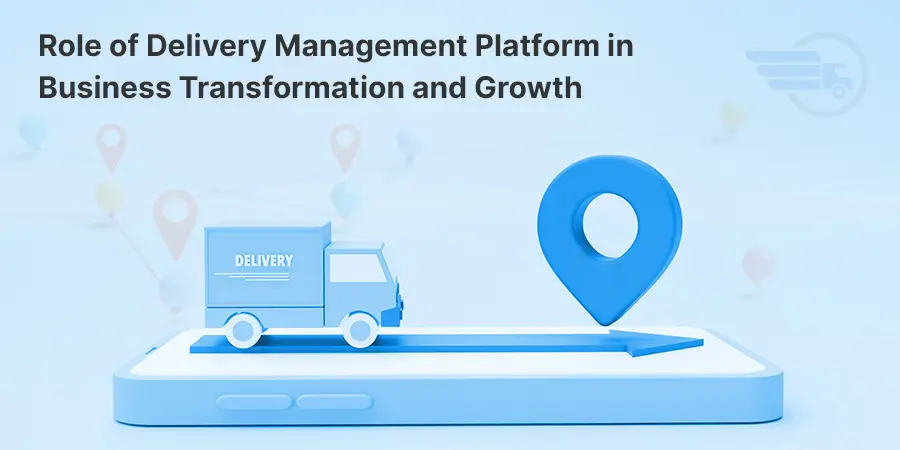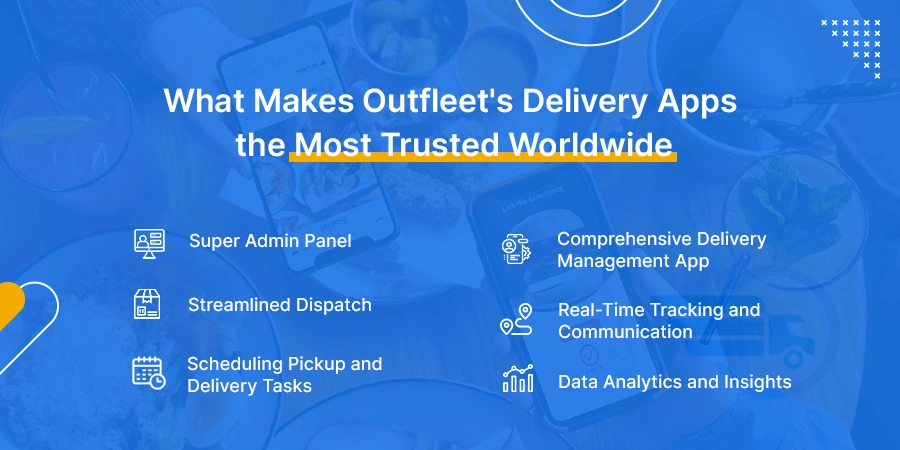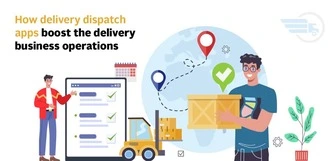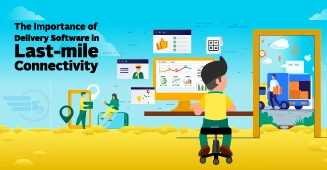10 Top Benefits of Implementing software for delivery management in your business
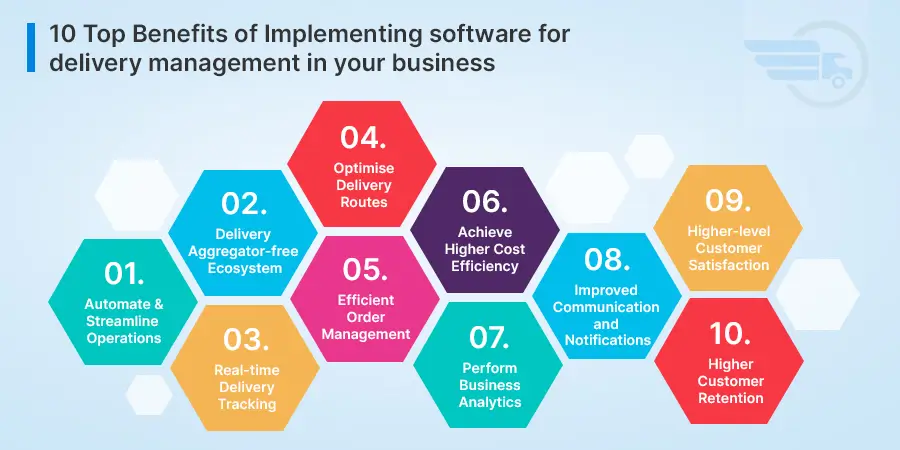
Software for delivery management is a powerful tool designed to streamline and optimise the process of managing and tracking deliveries for businesses. In an increasingly fast-paced and competitive market, businesses across various industries are turning to software to enhance operational efficiency, improve customer satisfaction, and drive growth.
Benefits of software for delivery management
This software provides end-to-end visibility into the entire delivery lifecycle, from order placement to final delivery, enabling businesses to effectively manage routes, assign tasks to drivers, track packages in real-time, and capture proof of delivery. With features like route optimization, real-time analytics, and automated notifications, it empowers businesses to optimise their logistics operations, minimise errors, and deliver exceptional customer experiences. We have listed the top 10 benefits for your reference.
1. Delivery Aggregator-free Ecosystem
Software for delivery offers numerous benefits by creating an aggregator-free Ecosystem. It is designed for seamless coordination and automation of delivery tasks. Through a centralised platform, businesses can easily communicate with drivers, customers, and other parties involved in the delivery process. Real-time notifications, automated alerts, and two-way messaging facilitate seamless coordination, ensuring smooth operations and quick problem resolution. Improved communication enhances the overall efficiency and effectiveness of the delivery process, leading to satisfied customers and stronger business relationships.
By leveraging this innovative software, businesses can enhance their delivery processes, increase operational efficiency, and deliver exceptional customer experiences, ultimately leading to business growth and success.
2. Real-time Delivery Tracking
Software for delivery management enables real-time tracking of shipments. With GPS-enabled tracking, businesses can monitor the precise location of their deliveries at any given time. This feature allows for accurate ETA (Estimated Time of Arrival) calculations, enabling businesses to provide customers with up-to-date information regarding their deliveries. Real-time tracking ensures transparency and helps businesses proactively address any potential delays or issues that may arise during the delivery process. It enhances customer satisfaction by offering a seamless and reliable experience.
It allows for optimised routing and dynamic adjustments. Real-time tracking data feeds into the software's algorithms, enabling businesses to identify the most efficient routes for their drivers. This optimization helps minimise fuel consumption, reduce travel time, and increase the number of deliveries that can be made within a given timeframe. Furthermore, if unexpected changes occur, such as traffic congestion or road closures, the software can dynamically adjust routes in real-time, ensuring the fastest and most efficient path to the destination. Real-time tracking and route optimization work together to maximise operational efficiency and productivity.
The software is preferred because it can provide accurate and timely updates to customers. It can automate the process of sending notifications and alerts to customers regarding the status of their deliveries.
3. Optimise Delivery Routes
With the help of advanced algorithms and real-time data analysis, software can optimise routes for drivers, resulting in improved efficiency, cost savings, and enhanced customer satisfaction. This is achieved by considering multiple factors such as delivery locations, traffic conditions, and driver availability. By calculating the most efficient routes, it reduces unnecessary mileage and travel time. This not only saves fuel costs but also minimises wear and tear on vehicles, leading to reduced maintenance expenses. Ultimately, route optimization maximises productivity by allowing drivers to complete more deliveries in less time, increasing overall operational efficiency.
Route optimization improves customer satisfaction. By ensuring that deliveries are made in the most efficient manner, software reduces the chances of late or missed deliveries. Customers benefit from accurate estimated arrival times, proactive notifications, and the ability to track their packages in real-time.
4. Higher-level Customer Satisfaction
Software for delivery management enhances customer satisfaction by providing accurate delivery tracking information, ensuring efficient and timely deliveries, and enabling proactive customer communication. These benefits not only contribute to a positive customer experience but also foster customer loyalty and promote repeat business. By leveraging the capabilities of delivery management software, businesses can effectively meet customer expectations, enhance their brand reputation, and create a competitive edge in the market.
5. Efficient Order Management
Software for delivery management offers a wide range of benefits for efficient order management. It simplifies and automates the order management process. It allows businesses to efficiently receive and process customer orders, track inventory levels, and manage order fulfilment. By centralising and automating these tasks, businesses can save time, reduce errors, and improve overall order accuracy.
The software provides real-time visibility into the status of orders and deliveries. It allows businesses to track shipments, monitor driver activities, and provide accurate delivery updates to customers. . By leveraging these features, businesses can enhance their overall order management process, deliver excellent customer experiences, and achieve greater productivity in their logistics operations.
6. Automate and Streamline Operations
Software for delivery management streamlines and automates various aspects of the delivery process. By eliminating manual tasks, optimising routes, and providing real-time tracking and visibility, businesses can achieve operational efficiency, reduce costs, enhance customer satisfaction, and gain a competitive edge in the market. The software revolutionises logistics operations, allowing businesses to focus on providing exceptional delivery experiences and growing their customer base.
7. Achieve Higher Cost Efficiency
Through advanced route planning and optimization algorithms, the software considers various factors such as delivery locations, traffic conditions, and vehicle capacities to create the most efficient routes. This optimization minimises fuel consumption, reduces wear and tear on vehicles, and ultimately lowers transportation costs.
With real-time tracking and dispatching features, businesses can assign tasks to drivers based on their proximity to the delivery locations. This eliminates unnecessary travel and idle time, ensuring that resources are utilised effectively. It provides visibility into driver performance and productivity, allowing businesses to identify areas for improvement and implement measures to enhance operational efficiency. These improvements minimise the need for re-deliveries, enhance customer satisfaction, and reduce associated costs.
8. Perform Business Analytics
Software for delivery management offers significant benefits in terms of business analytics and insights. By leveraging the data collected throughout the delivery process, businesses can make data-driven decisions, track performance, and improve operational efficiency. Furthermore, the software provides valuable customer insights, enabling businesses to personalise experiences and enhance customer satisfaction. It is used in:
Performance Tracking and Analysis: Real-time tracking of drivers and packages enables businesses to monitor delivery progress, identify any delays or issues, and take corrective actions promptly. By analysing performance metrics, such as on-time delivery rates, driver productivity, and customer feedback, businesses can identify trends, areas for improvement, and implement strategies to enhance performance and exceed customer expectations.
Customer Insights and Personalization: It captures valuable customer data, including delivery preferences, order history, and feedback. By integrating this data with customer relationship management (CRM) systems or customer databases, businesses can gain a holistic view of their customers.
9. Improved Communication and Notifications
With its robust features and functionalities, this software facilitates efficient communication between various stakeholders involved in the delivery chain. It enables businesses to provide real-time updates to customers regarding their orders, including tracking information, estimated delivery times, and any potential delays. This transparent and proactive communication helps to build trust and confidence in the business, leading to increased customer satisfaction.
Secondly, the software promotes effective communication between the business and its delivery personnel. It enables businesses to assign and communicate delivery tasks to drivers efficiently, ensuring they have accurate information about the packages, delivery addresses, and any special instructions. It allows for seamless communication through integrated messaging or chat functionalities, enabling drivers to seek clarification, report any issues, or update their status in real-time. This facilitates smoother coordination between the business and the drivers, enhancing operational efficiency and minimising errors.
It centralises all relevant delivery information, including order details, customer preferences, and delivery history, in one accessible platform. This eliminates communication gaps and ensures that everyone involved in the delivery process, such as warehouse staff, customer service representatives, and management, has access to accurate and up-to-date information. Improved internal communication enables teams to collaborate effectively, make informed decisions, and resolve any issues promptly, leading to a more streamlined and successful delivery operation.
10. Higher Customer Retention
By leveraging the capabilities of the software, businesses can optimise their delivery processes, resulting in improved customer experiences and increased loyalty. Here are three key ways in which software contributes to higher customer retention:
Efficient and Timely Deliveries: Satisfied customers are more likely to continue using the services or products of a company, contributing to higher customer retention rates.
Enhanced Communication and Transparency: High level of transparency creates a sense of trust and confidence in the business. Customers appreciate being informed and having control over their deliveries, leading to improved satisfaction and an increased likelihood of repeat business.
Cost Savings and Value for Customers: Cost savings can be passed on to customers in the form of competitive pricing or value-added services. Offering value to customers through affordable and reliable deliveries enhances their perception of the business and encourages them to remain loyal, contributing to higher customer retention rates.
The benefits of software for delivery management are extensive and contribute to higher customer retention rates. By enabling efficient and timely deliveries, enhancing communication and transparency, and providing cost savings and value to customers, businesses can foster customer loyalty and long-term relationships. By leveraging the power of delivery management software, businesses can achieve higher customer retention rates, strengthen their market position, and drive sustainable growth.
Latest Posts
- Transforming E-commerce: How Seamless Order Management Enhances Customer Experience
- Fast Track Optimization: The Art and Science of the Most Efficient Route Planner
- Mastering Efficiency: The Role of Real-time Tracking Solutions in Restaurant Business
- The Future of Delivery: How Streamlined Logistics Can Transform Your Operations
- Real-time Handling: Key to Solving Dispatch Delivery Problems
- The Powerful Impact of Grocery Delivery Management System on Retail Business
- Benefits of an Automated Dispatch Software for your Business
- Six Essential Task-handling Features in Delivery Tracking System Software
- 8 Reasons to Implement Software-based Dispatch Management in this Era
- Reengineering Urban Mobility: Unveiling the Power of Dispatch Delivery Management System
